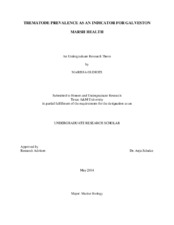Trematode Prevelance as an Indicator for Galveston Marsh Health
Abstract
Digenean trematodes have complex life histories involving several hosts and life stages. They are sensitive to biotic and abiotic factors such as metal pollutants and extreme pH and temperature, possibly making them valuable bioindicators for natural and anthropogenic disturbances. To test this, trematode diversity in the plicate horn snail, Cerithidia pliculosa, from four different marsh systems around Galveston, including relatively pristine marshes, marshes heavily impacted by garbage and recently restored marshes, was evaluated to determine whether trematodes can be used locally as a bioindicator for marsh health. The snails from the marsh near East Lagoon a marsh with a high incidence of anthropogenic garbage, had a 92% infection rate with 7 of the 8 species found in this study while the marsh along Highway 45, an old restored marsh, only had a 7% infection rate with 2 of the 8 species found. The third marsh, located near Sportsman’s Road in West Galveston Bay had 3 species of parasites with a 33% infection rate. The fourth marsh was excluded from further analysis, as not enough host snails could be collected. The differences in trematode prevalence could be attributed to a number of factors such as recreational fishing activities, pollution, host density and physical properties of the marshes. Further studies are necessary to accurately determine whether trematode diversity in Galveston is a factor of natural or anthropogenic affects.
Subject
Trematode PrevalenceGalveston
Marsh
Marshes
Bioindicator
plicate horn snail
Cerithidea pliculosa
Citation
Oldiges, Marissa C (2014). Trematode Prevelance as an Indicator for Galveston Marsh Health. Undergraduate Research Scholars Program. Available electronically from https : / /hdl .handle .net /1969 .1 /157584.


